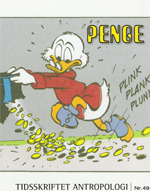NÅR „PENGE“ ER ANDET OG MERE END PENGE: Røde fjerruller på Reef Øerne
DOI:
https://doi.org/10.7146/ta.v0i49.106651Resumé
Until the middle of the 20th century red feather rolls were an important and highly
visible aspect of social life in the the Northern Santa Cruz Islands comprising Nendö,
Reef Islands and Duff Islands. These rolls, commonly but misleadingly known and
referred to as “red feather money” even in anthropological literature, by the 1970s had
nearly gone out of use and by the 1990s they had disappeared. In this historical
reconstruction the red feather rolls are viewed in their heyday in their regional as well
as their local social context. The ethnographic knowledge behind the reconstruction is
based on all the available sources of the precolonial and colonial periods, the major
anthropological analyses of the 1960s and the 1970s and my own fieldwork data
established after 1973. The anthropological analysis of the material takes guidance
from Maurice Godelier (1978) who points out that valuables in primitive society often
have a dual character, they are both commodities and gifts; and from Kajsa Ekholm
(1978) who states that power relations in tribal societies are largely established,
consolidated and maintained through the control of valuables. Red feather rolls played
an important part in the regional trading system connecting the Northern Santa Cruz
Islands. This peculiar form of valuable was only produced in the rich central island of
Nendö from where it was taken to the more marginal islands as part of the inter-island
trading, usually in exchange of women. The big trading canoes were only built in the
Duff Islands and had to be for paid in red feather rolls. They were owned and sailed by
the leading big-men in the Western Reef Islands who accordingly were able to exercise
considerable control over the influx and the flow internally of the feather rolls. Feather
rolls were indispensable in the gift-exchanges accompanying all major social ceremonies
and events such as bridewealth, compensations and life-cycle ceremonies. So a generous
local big-man could use his feather rolls for the benefit of his relatives and favoured
friends who were in need of it, and at the same time he would make them into his loyal
supporters. In this social system, control of the unique valuable was the major road to
respect and influence, even to power, for the big-man. The red feather rolls were part
of an intricate local social order which depended for its reproduction on the regional
trading system. But all this had to disappear when market economy based on western
money, Christian influence, and colonial control took over. The regional trading system
collapsed; the red feather rolls lost their significance and the big-men the base of their
power.
Downloads
Publiceret
Citation/Eksport
Nummer
Sektion
Licens
Ophavsretten til artiklerne i Tidsskriftet Antropologi tilfalder forfatteren.
Artikler publiceret i Tidsskriftet Antropologi må citeres, downloades og videresendes for ikke-kommerciel brug, under forudsætning af normal akademisk reference til forfatter(e) samt tidsskrift, årgang, nummer og sider. Artiklerne må kun genudgives med eksplicit tilladelse fra forfatter(e) og tidsskriftet.


